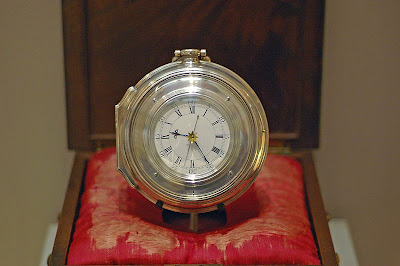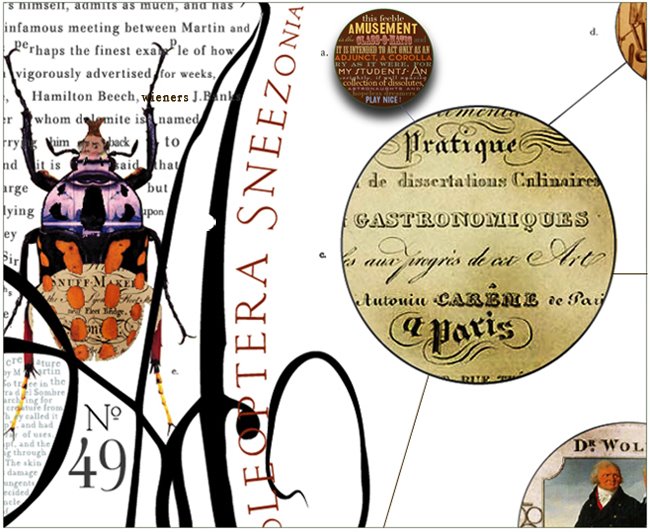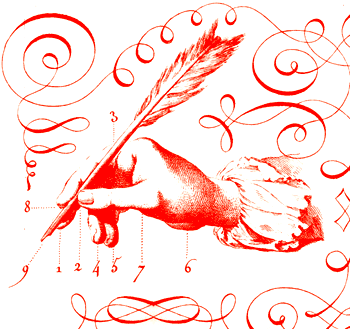
Sunday, June 29, 2008
Mid to late Victorian, home-front and colonial graphic amusements - as well as the now classic, caveat/bromide for war torn Englando, the "Keep Calm & Carry On" it will be alright directive - which I can vividly remember my Uncle Kenneth uttering quite often, usually after he'd fallen down due to some post stress syndrome related gin and tonic accident.
The sign, which I never actually saw in situ, (so no, you're so old jokes) was a kind of 1940's, "Don't worry be happy" ... duck and roll ... stiff upper lip kind of - 'Ministry think' that Orwell and the 60's both abhorred. Cynics may opine, that we love to be told what to do. I have my doubts.
Thursday, June 19, 2008
What can you really say ? Bizarre, or brilliant, a small rug, made of meat.
Ok , it just looks likes "luncheon utility" meat. Yum ! Creepy weird, big silly.
ahh Perfect ! Both the carpets and the meat, is available for sale.




Ok , it just looks likes "luncheon utility" meat. Yum ! Creepy weird, big silly.
ahh Perfect ! Both the carpets and the meat, is available for sale.




Wednesday, June 18, 2008
Lovely, and rich with a sad, sad history. An early, beautiful silver wrist
watch, with a porcelain crown. dated 1915. Hand painted dial.
Imagine the history behind this watch. Worn by a Red Cross medical
person, around your age. Probably a Doctor, or a Nurse, working deep in
the trenches during the First World War. In the horrible thick mud and
pelting rain, constant freezing cold, the terrible smells and sounds of death
everywhere about you, the relentless monotony.
Was it at Marne, Somme or Ypres, this watch was worn ?

Where ever the battles were dreadful in their casualties and whoever, undoubtedly
extraordinarily brave, wore this watch, was a very special person putting
their life at risk for others.
.jpg)
.jpg)
.jpg)

.JPG)
.JPG)
In the 1700’s, Queen Anne of England wanted to extend her vast maritime
power and offered a huge prize reward of 20,000 pounds for anyone who invented
something that reliably calculated longitude. ( you can both read a great book or
watch the film, which chronicles the remarkable brilliance and long suffering
tribulations of Mr. Harrison, both of which, are called, oddly enough - Longitude )
A self-taught watchmaker by the name of John Harrison discovered that a
precise reading of a ships longitude could only happen if you knew the exact
time. At this point, Harrison decided that he needed to create a watch that was
far more accurate then what was available at that time. He worked for more then
ten years to create 4 versions of the Harrison Marine Chronometer. He presented
his plate sized watch to the royal academy and had his chronometers tested by
people like Captain Cook.
Harrison’s Marine Chronometer went through many trials of both a scientific as
well as the human kind - but he was, eventually, after years of hardship, disappointment and nefarious intrigue - awarded the prize money by the Longitude Board for the Crown.
It took until the 19th century for the wristwatch technology to come to fruition.
The wristwatch was invented by Patek Philippe. From the time of its invention
until world war one, the wristwatch was mainly considered something that a
woman would wear.
Men, to that point had generally used pocket watches. In the midst of war, some
armies soon realized that it was much easier to glance at your wrist to check the
time, than it was to fumble around in your jacket to find your pocket watch. When
the war ended, the soldiers got to keep their army issued wristwatches.



They must have gotten used to wearing a wristwatch everyday, because soon after
the war ended, it became common to see civilian men wearing wristwatches in public.
One might surmise, if in the mood to make both broad and rather coarse generalizations - that World War 1, was the one principle event that spurred the wristwatch industry.
Harrison's masterpiece, his Chronometer H5

watch, with a porcelain crown. dated 1915. Hand painted dial.
Imagine the history behind this watch. Worn by a Red Cross medical
person, around your age. Probably a Doctor, or a Nurse, working deep in
the trenches during the First World War. In the horrible thick mud and
pelting rain, constant freezing cold, the terrible smells and sounds of death
everywhere about you, the relentless monotony.
Was it at Marne, Somme or Ypres, this watch was worn ?

Where ever the battles were dreadful in their casualties and whoever, undoubtedly
extraordinarily brave, wore this watch, was a very special person putting
their life at risk for others.
.jpg)
.jpg)
.jpg)

.JPG)
.JPG)
In the 1700’s, Queen Anne of England wanted to extend her vast maritime
power and offered a huge prize reward of 20,000 pounds for anyone who invented
something that reliably calculated longitude. ( you can both read a great book or
watch the film, which chronicles the remarkable brilliance and long suffering
tribulations of Mr. Harrison, both of which, are called, oddly enough - Longitude )
A self-taught watchmaker by the name of John Harrison discovered that a
precise reading of a ships longitude could only happen if you knew the exact
time. At this point, Harrison decided that he needed to create a watch that was
far more accurate then what was available at that time. He worked for more then
ten years to create 4 versions of the Harrison Marine Chronometer. He presented
his plate sized watch to the royal academy and had his chronometers tested by
people like Captain Cook.
Harrison’s Marine Chronometer went through many trials of both a scientific as
well as the human kind - but he was, eventually, after years of hardship, disappointment and nefarious intrigue - awarded the prize money by the Longitude Board for the Crown.
It took until the 19th century for the wristwatch technology to come to fruition.
The wristwatch was invented by Patek Philippe. From the time of its invention
until world war one, the wristwatch was mainly considered something that a
woman would wear.
Men, to that point had generally used pocket watches. In the midst of war, some
armies soon realized that it was much easier to glance at your wrist to check the
time, than it was to fumble around in your jacket to find your pocket watch. When
the war ended, the soldiers got to keep their army issued wristwatches.



They must have gotten used to wearing a wristwatch everyday, because soon after
the war ended, it became common to see civilian men wearing wristwatches in public.
One might surmise, if in the mood to make both broad and rather coarse generalizations - that World War 1, was the one principle event that spurred the wristwatch industry.
Harrison's masterpiece, his Chronometer H5

Sunday, June 15, 2008
Linotype - typesetters from hell ...
Imagine a gas powered desktop publishing system that weighed several
tons,leaked oil, had thousands of moving parts, its own boiler full of molten
lead and a keyboard where you couldn’t see what you had typed and which
looked a thousand times more strange and complicated than any deliberately
anachronistic ‘Steampunk’ PC casemod neo punk device.



This is how the machines that laid out the pages of newspapers were till the 1980's, and to give you some idea of how recent this technology was used, they were manufactured until after the release of the Apple computer.
Linotype had a virtual monopoly on the typesetting of newspapers for a hundred years and their design is a superb example of an endlessly refined solution to what became an anachronistic problem.
Linotypes were unlike any keyboard driven device, before or since. Next time, you wienies complain about the complexities of setting type on a Mac, remember these beasts, just back behind the corner, barely an arms lengths away. When I was a student we had to learn how to both use and maintain them. Naked. on fire, while running. OK not naked.
Imagine a gas powered desktop publishing system that weighed several
tons,leaked oil, had thousands of moving parts, its own boiler full of molten
lead and a keyboard where you couldn’t see what you had typed and which
looked a thousand times more strange and complicated than any deliberately
anachronistic ‘Steampunk’ PC casemod neo punk device.



This is how the machines that laid out the pages of newspapers were till the 1980's, and to give you some idea of how recent this technology was used, they were manufactured until after the release of the Apple computer.
Linotype had a virtual monopoly on the typesetting of newspapers for a hundred years and their design is a superb example of an endlessly refined solution to what became an anachronistic problem.
Linotypes were unlike any keyboard driven device, before or since. Next time, you wienies complain about the complexities of setting type on a Mac, remember these beasts, just back behind the corner, barely an arms lengths away. When I was a student we had to learn how to both use and maintain them. Naked. on fire, while running. OK not naked.
Tim Walker is a photographer based in London. Tim’s interest in photography
began while working at Condé Nast where he set up the Cecil Beaton archive.
After graduating from Exeter Art College, he worked as a freelance photographic
assistant before working as Richard Avedon’s assistant in New York.
His career as a photographer was launched when he came third in the Independent
Young Photographer of the Year Award, and he went on to contribute to high-profile magazines including Vogue, W and Harper‘s Bazaar.
He has also shot advertising campaigns for clients including Barneys, Comme des
Garcons, Gap and Yohji Yamamoto.
Tim Walker is represented by Thomas Treuhaft









began while working at Condé Nast where he set up the Cecil Beaton archive.
After graduating from Exeter Art College, he worked as a freelance photographic
assistant before working as Richard Avedon’s assistant in New York.
His career as a photographer was launched when he came third in the Independent
Young Photographer of the Year Award, and he went on to contribute to high-profile magazines including Vogue, W and Harper‘s Bazaar.
He has also shot advertising campaigns for clients including Barneys, Comme des
Garcons, Gap and Yohji Yamamoto.
Tim Walker is represented by Thomas Treuhaft









Friday, June 13, 2008
Friday, June 06, 2008
The Good Citizen’s Alphabet
Bertrand Russell’s The Good Citizen’s Alphabet, with illustrations by Franciszka Themerson, was published in 1953.
Bertrand Russell, the English logician and philosopher, celebrated for his work in mathematical logic and known to a wider public for his social and political campaigns, was also a man with a great sense of humour.
This socio-political alphabet, written by Russell “for the guidance of the first steps of the infant mind”, started life as a private joke in correspondence between Russell and the Themersons, who decided to publish it.
Russell’s alphabet teaches far more than just the letters of the alphabet, as ‘A’ stands not for ‘apple’ but for ‘asinine: what you think’, followed by other ‘satirical letters’ such as ‘O’ for ‘objective: a delusion which other lunatics share’ and ‘L’ for ‘liberty: the right to obey the police’. Russell was delighted with the publication and said that Franciszka Themerson's drawings "heightened all the points I most wanted to make”.
A satire by both the philosopher and the illustrator, the book is compelling for the simplicity of its design, and for the mix of whimsical humour in the drawings with the satirical bite of the words.
“for all their appearance of naiveté, the book’s drawings are subtle, wise and funny – affectionate, ridiculous, merciless and moral all at once”.
“Bertrand Russell’s alphabet book is designed to improve the minds of the young in our acrimonious and utilitarian world.
It will encourage them remorselessly to deflate the loftiest sentiments and neatly to undermine the blandest attitudes of relatives, theorists and reformers”.
In The News Chronicle, Fredrick Laws said: "...wickedly and prettily illustrated... and designed to appeal to infant minds."









Bertrand Russell’s The Good Citizen’s Alphabet, with illustrations by Franciszka Themerson, was published in 1953.
Bertrand Russell, the English logician and philosopher, celebrated for his work in mathematical logic and known to a wider public for his social and political campaigns, was also a man with a great sense of humour.
This socio-political alphabet, written by Russell “for the guidance of the first steps of the infant mind”, started life as a private joke in correspondence between Russell and the Themersons, who decided to publish it.
Russell’s alphabet teaches far more than just the letters of the alphabet, as ‘A’ stands not for ‘apple’ but for ‘asinine: what you think’, followed by other ‘satirical letters’ such as ‘O’ for ‘objective: a delusion which other lunatics share’ and ‘L’ for ‘liberty: the right to obey the police’. Russell was delighted with the publication and said that Franciszka Themerson's drawings "heightened all the points I most wanted to make”.
A satire by both the philosopher and the illustrator, the book is compelling for the simplicity of its design, and for the mix of whimsical humour in the drawings with the satirical bite of the words.
“for all their appearance of naiveté, the book’s drawings are subtle, wise and funny – affectionate, ridiculous, merciless and moral all at once”.
“Bertrand Russell’s alphabet book is designed to improve the minds of the young in our acrimonious and utilitarian world.
It will encourage them remorselessly to deflate the loftiest sentiments and neatly to undermine the blandest attitudes of relatives, theorists and reformers”.
In The News Chronicle, Fredrick Laws said: "...wickedly and prettily illustrated... and designed to appeal to infant minds."









The China Syndrome (it's an old movie reference)
A visit to the construction site of the National Stadium in Beijing is as close as you get in the 21st century to seeing what it must have been like to build the Great Wall of China.
At one point, there were 7,000 workers, human waves, toiling on the stadium, dispatched in six-month stints from the countryside and organized like an army of ants into squadrons.
 Eventually, their numbers diminished to a couple of thousand: the concrete long poured for the huge bowl that will seat 91,000 screaming spectators at the 2008 Olympic Games, and the raising and welding of the steel columns and beams — tasks that require extra training and elbow room — are now nearly complete.
Eventually, their numbers diminished to a couple of thousand: the concrete long poured for the huge bowl that will seat 91,000 screaming spectators at the 2008 Olympic Games, and the raising and welding of the steel columns and beams — tasks that require extra training and elbow room — are now nearly complete.Cranes more than 300 feet tall hovered above, hoisting metal pieces as heavy as 350 tons to form an extraordinary lattice of interwoven steel.
Knowing that the nickname "bird's nest" has clicked with the Chinese psyche, one can imagine the enormous cranes as Godzilla-fied birds and the dangling curves of steel as worms being lowered for the chicks.
The 24 main columns are gargantuan — 1,000 tons each, far more than the weight of those in typical stadia and spaced in what appears to be a random pattern.
" Everyone thinks this is the most remarkable piece of architecture we have ever designed," the architect Jacques Herzog said, and "To realize that project there is amazing."
It defies expectations to see this avant-garde building rising in China, and yet, Herzog had remarked, "such a structure you couldn't do anywhere else."
For architects, China is the land of dreams. The construction statistics tantalize.
The Chinese consume over 55 percent of the concrete and nearly 50 percent of the steel produced in the world. Hungry architects are drawn to China by the abundance of economic opportunities and no doubt, the very loose, and politically elastic, health, environment and worker safety standards. But Herzog & de Meuron, the Swiss firm that designed the stadium, doesn't need to drum up business. It has more work than it can handle.
What attracted the firm to China is an openness to audacious projects, which they attribute to the lack of timidity and inhibition in the people there.
"They are so fresh in their mind," Herzog says. "They have the most radical things in their tradition, the most amazing faience and perforated jades and scholar's rocks. Everyone is encouraged to do their most stupid and extravagant designs there. They don't have as much of a barrier between good taste and bad taste, between the minimal and expressive. The Beijing stadium tells me that nothing will shock them."




After Beijing was awarded the Olympic Games, the city authorities, with national encouragement, set out to display the material progress of their society. A euphoric wave of architectural commissions ensued, as the Olympics have galvanized China's imperial impulse to impress the world, by whatever means necessary.
Subscribe to:
Posts (Atom)












